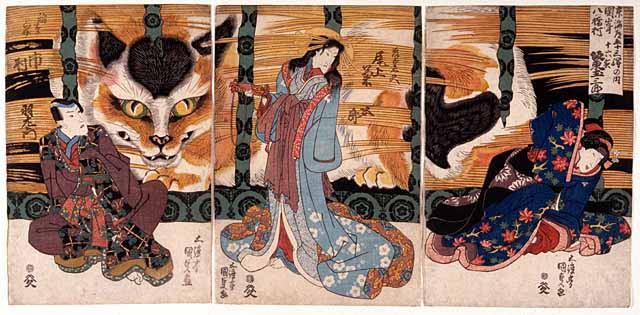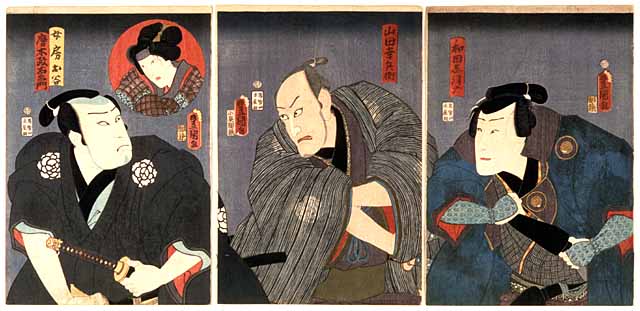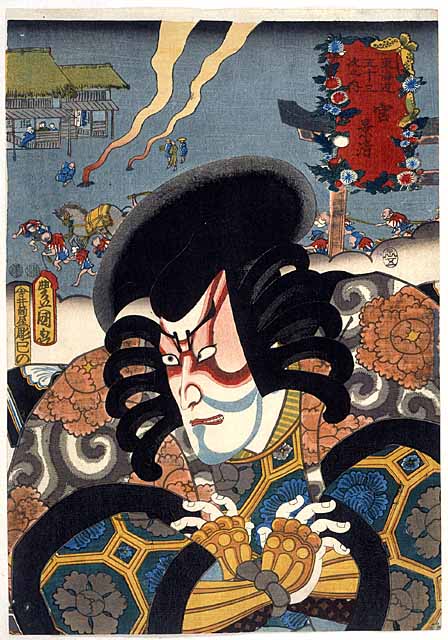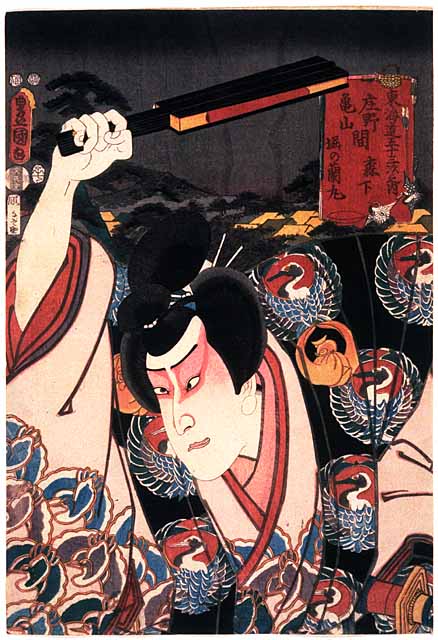
The village of eight bridges at Okazaki (Okazaki Yatsuhashi-mura) 1838
Given by the Friends of the Fitzwilliam with the aid of the MGC Purchase Grant Fund and the National Art Collections Fund.
From the series ‘Fifty-three stations of the Tokaido Highway’ (Tokaido gojusan tsugi no uchi) published by Yamamotoya Heikichi. The triptych depicts Bando Tamasaburo I as Izayoi (right), Onoe Kikugoro III as Usugumo Dayu (centre) and Ichimura Uzaemon XII as Inaba no suke (left) in Ume no haru gojusan tsugi (Fifty-three stations with plum blossoming in Spring) performed at the Ichimura theatre from 23/02/1835. The roles on the print do not directly correspond to those performed by the actors on stage, indicating that the print was published in advance of the performance, before the roles were fixed. The play took episodes associated with each of the staging-posts on the Tokaido highway between Edo (Tokyo) and Kyoto, and assembled them into an omnibus-like plot. Some of these involved apparitions.
A legend told that the houses along the road at Okazaki were haunted by a giant cat. This triptych relates to the scene Okazaki neko-ishi no kai (The spirit of the Cat Rock at Okazaki), in which the giant cat-spirit appeared.
Plots involving cat-spirits belong to a category of play derived from the puppet theatre, called Neko sodo mono (‘Cat-family dispute play’), which usually concerned people who wreaked havoc after being possessed by an evil cat-spirit. The first such Kabuki play was popularly known as Okazaki no neko (The Cat of Okazaki) because of the episode in which a mother was possessed by a cat-spirit and took up residence in an old temple at Okazaki, where she practised cat witchcraft. It was first produced in 1827, starring Onoe Kikugoro III, and was based on the picaresque novel by Jippensha Ikku, Tokaidochu hiza kurige (On Shanks’s Mare along the Tokaido), which told the story of two comic characters from Edo making their way along the Tokaido.

Onoe Baiko as Wada Shizuma (right), Ichikawa Ebizo V as Yamada Kobei (centre) and Kataoka Nizaemon VIII as Karaki Masaemon with an inset of Onoe Kikugoro IV as his wife O-Tani (left)
01/1859
Given by the Friends of the Fitzwilliam with the aid of the MGC Purchase Grant Fund and the National Art Collections Fund.
Onoe Baiko as Wada Shizuma (right), Ichikawa Ebizo V as Yamada Kobei (centre) and Kataoka Nizaemon VIII as Karaki Masaemon with an inset of Onoe Kikugoro IV as his wife O-Tani (left)
A scene from an Iga revenge drama (Igagoe mono) that conflated the plots of two established plays (Igagoe Norikake Gappa and Igagoe docho sugoroku). The plot, based on a true story, involves the efforts of Wada Shizuma and his brother-in-law Karaki Masaemon, to pursue the villainous Matagoro, who has murdered Shizuma’s father Yukie. Their pursuit takes them along the Tokaido Highway. In this act, Shizuma reaches the Fuji River barrier and with the help of Osode the tea-shop girl, heads towards Okazaki, with Masaemon close behind. Although Osode is betrothed to Matagoro (whom she has never seen), she falls in love with Shizuma, who passes himself off as Matagoro.
They reach the house of her father, Yamada Kobei, whom Masaemon recognizes as his old fighting teacher. Not knowing that these men are his enemies, Kobei asks Masaemon to aid Matagoro (his daughter’s betrothed). Masaemon pretends to agree. His distraught wife Otani, whom he has divorced in order to gain his master’s permission to let him help Shizuma, arrives outside the house, and collapses in the snow. Not wanting distractions, Masaemon grabs the infant that she is carrying and dispatches Otani to a nearby shrine. Back at the house, the men find a note inside the child’s amulet identifying him as Masaemon’s son. To show his loyalty, Masaemon kills the child and asks Kobei where Matagoro’s is hiding. But Kobei has already divined the men’s identities. Realising that they are in his debt he knows that honour demands that he must break his bond with Matagoro so that their vendetta can be played out.
Collections Record: P.77-1999

Miya Kagekiyo
05/1852
Given by the Friends of the Fitzwilliam with the aid of the MGC Purchase Grant Fund and the National Art Collections Fund.
A portrait of Ichikawa Danjuro VIII as Kagekiyo, with a view of Miya on the Tokaido Highway in the background, from the series Tokaido gojusan tsugi no uchi (Fifty-three stations of the Tokaido Highway).
Akushichibyoe Kagekiyo, a leading Heike warrior in the Gempei wars, featured only briefly in the historical chronicle Heike Monogatari (Tale of the Heike) but assumed great prominence in legend and in numerous kabuki and puppet dramas known as Kagekiyo mono (Kagekiyo plays). One version was included by Danjuro VII in his selection of Eighteen Plays (Kabuki Juhachiban) specially associated with the Ichikawa lineage. The role called for the Ichikawa speciality of aragoto (‘rough-stuff’) acting, with a dotera (padded-dressing-gown) costume, huge bushy wig and red make-up (beni suji) with suji gama (‘line shadows’) and painted blue beard (han guma).
As with all the prints in this series (two of them included here), the landscape in the background is heavily indebted to a print in Hiroshige’s famous series of Tokaido views published 20 years earlier.
Collections Record: P.60-1999

Shôno Kameyama kan Morishita Hori no Rammaru (Morishita, between Shono and Kameyama: Hori no Rammaru)
10/1852
Given by the Friends of the Fitzwilliam with the aid of the MGC Purchase Grant Fund and the National Art Collections Fund.
A portrait of Ichikawa Saruzo as Hori no Rammaru, with a view of Morishita on the Tokaido Highway in the background, from the series Tokaido gojusan tsugi no uchi (Fifty-three stations of the Tokaido Highway). As with all the prints in this series (two of them shown here), the landscape in the background is heavily indebted to a print in Hiroshige’s famous series of Tokaido views published 20 years earlier. According to the advertisements for the series, Kunisada was inspired by the late Onoe Kikugoro III (1784-1849) who, in the last year of his life, had walked the length of the Tokaido giving performances along the way.
The publication was so ambitious that four publishers collaborated: Izutsaya, Iseya, Tsugiokaya and Sumiyoshiya. Initially the plan was for the whole series to be cut by the block-carver Yokogawa Takejiro and printed by Oumiya Hisagoro, but the size of the project led to other craftsmen being brought in.
Collections Record: P.62-1999



